Flowers are nature’s way of adding color and beauty to our surroundings. From vibrant roses to delicate lilies, each flower has its unique charm. Among the many flowers available, those starting with B stand out with their remarkable beauty and exquisite fragrance. In this blog post, we’ll introduce you to 30 flowers starting with B that will leave you in awe. Whether you’re a gardening enthusiast or simply appreciate the beauty of nature, these stunning blooms will captivate your heart. So, let’s dive in and explore the magical world of flowers starting with B!
Why Use Flowering Plants That Start With B
Using flowering plants that start with B can be a fantastic choice for several reasons. For one, it can add an interesting and unique dimension to your garden or landscaping. With so many different types of B flowers to choose from, you can create a vibrant and diverse display that will surely catch any passerby’s eye.
In addition to their visual appeal, many B flowers also offer a variety of practical benefits. Some, like the Bee Balm, attract beneficial pollinators such as bees and butterflies, while others, like the Buttercup, can help to improve soil quality. Plus, many B flowers are known for their therapeutic properties and are used in traditional medicine for their healing qualities.
Overall, using flowering plants that start with B can be a great way to enhance your garden’s beauty while also reaping some practical benefits. So why not add some “B”-eautiful blooms to your outdoor space today?
How To Use Flowering Plants That Start With B
You can use flowering plants that start with B to add beauty and interest to your garden or landscaping. Here are a few ideas to get you started:
- Create a focal point: Choose a standout B flower like the Bird of Paradise or the Blue Poppy and use it as a centerpiece in your garden or landscaping. This will draw the eye and create a dramatic effect.
- Plant in groups: Many B flowers like the Barberton Daisy or the Bearded Iris look best when planted in clusters. Planting them in groups will create a beautiful mass of color and texture.
- Add contrast: Using B flowers with different colors and textures can add contrast and interest to your garden. Pair a delicate flower like the Bluebell with a more substantial bloom like the Black-eyed Susan for a stunning effect.
- Attract pollinators: Many B flowers, like the Bee Balm and the Blue Columbine, are known for their ability to attract beneficial pollinators like bees and butterflies. Planting these flowers can help to create a thriving ecosystem in your garden.
- Create a themed garden: Consider creating a garden featuring only B flowers or using them as part of a broader themed garden. This can be a fun way to explore the variety of B flowers available and create a cohesive and visually appealing outdoor space.
Overall, there are countless ways you can use flowering plants that start with B to enhance your garden or landscaping. Whether you’re looking to create a focal point, attract pollinators, or add color and interest to your outdoor space, B Flowers can be a great choice.
1. Baby’s Breath
Baby’s breath, also known as Gypsophila, is a delicate and charming flower that is commonly used as a filler in flower arrangements. The small, white or pink flowers bloom in clusters atop long, thin stems and give off a sweet, light fragrance. Baby’s breath is easy to care for and can thrive in a variety of growing conditions, making it a popular choice for both novice and experienced gardeners.
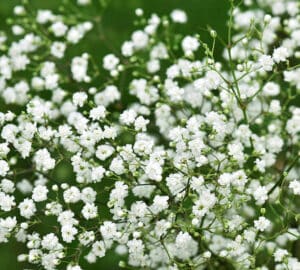
If you plan to grow baby’s breath, it’s best to plant the seeds in the spring or fall, in a well-draining soil that is rich in organic matter. Sow the seeds thinly, about 1/8 inch deep, and keep the soil moist until the seedlings emerge. Once the seedlings are about 2 inches tall, thin them out to about 12 inches apart.
Baby’s breath prefers full sun but can also tolerate partial shade. Water the plants regularly, especially during hot, dry weather, and fertilize with a balanced fertilizer every 6-8 weeks during the growing season. With proper care, baby’s breath can produce an abundance of lovely flowers throughout the season, adding a touch of elegance to any garden or floral arrangement.
2. Balloon Flower
The balloon flower, also known as Platycodon grandiflorus, is a charming and unique flower that is native to East Asia. The name of this flower comes from the inflated balloon-like buds that open up to reveal a beautiful, star-shaped flower. The flowers come in a range of colors, including blue, white, pink, and purple, and bloom in the summer months.
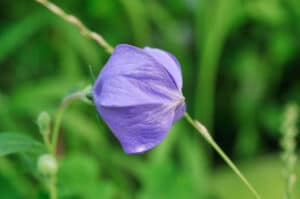
To grow balloon flowers, it’s best to plant them in a location that receives full sun to partial shade. The soil should be well-draining and rich in organic matter. Sow the seeds indoors in early spring or plant them directly in the garden once the soil has warmed up.
When planting balloon flowers, make sure to space them about 12 inches apart to give them room to grow. Water them regularly, especially during hot, dry weather, and fertilize with a balanced fertilizer every 6-8 weeks during the growing season.
One unique feature of the balloon flower is that it is a long-lived perennial, meaning it can survive for several years with proper care. However, it’s important to note that the plant may take a year or two to establish itself before producing an abundance of blooms. With patience and proper care, the balloon flower can be a delightful addition to any garden.
3. Barberton Daisy
The Barberton Daisy, also known as Gerbera Jamesonii, is a bright and cheerful flower that is native to South Africa. It is prized for its large, daisy-like flowers that come in a range of colors, including pink, yellow, orange, and red. Barberton Daisies are popular in flower arrangements and can also be grown in a garden setting.
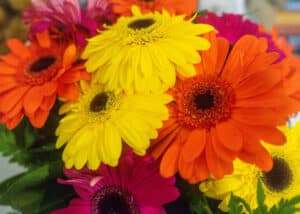
To grow Barberton Daisies, it’s best to plant them in a location that receives full sun to partial shade. The soil should be well-draining and rich in organic matter. Sow the seeds indoors in late winter or early spring or plant them directly in the garden once the soil has warmed up.
When planting Barberton Daisies, make sure to space them about 12 inches apart to give them room to grow. Water them regularly, especially during hot, dry weather, and fertilize with a balanced fertilizer every 6-8 weeks during the growing season.
One important tip for growing Barberton Daisies is to protect them from frost. They are not cold-hardy plants and should be brought indoors or covered during cold weather. With proper care, Barberton Daisies can bloom for several months, providing a burst of color and cheer to any garden or indoor space.
4. Basket Of Gold
The Basket of Gold, also known as Aurinia saxatilis, is a charming and easy-to-grow perennial that is native to Europe and Asia. It is named for its abundant clusters of bright yellow flowers that resemble small baskets of gold. The flowers bloom in the spring and can last for several weeks.
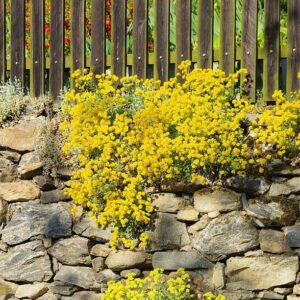
To grow Basket of Gold, it’s best to plant them in a location that receives full sun and has well-draining soil. They can tolerate some shade but will produce more flowers in full sun. Sow the seeds in the fall or early spring, about 1/4 inch deep, and keep the soil moist until the seeds germinate.
When planting Basket of Gold, make sure to space them about 12 inches apart to give them room to grow. Water them regularly, especially during hot, dry weather, and fertilize with a balanced fertilizer every 6-8 weeks during the growing season.
One unique feature of the Basket of Gold is that it is a low-growing plant, reaching only 6-12 inches in height. This makes it ideal for planting in rock gardens, along borders, or in containers. With proper care, the Basket of Gold can provide a bright burst of color to any garden or outdoor space.
5. Bearded Iris
The Bearded Iris is a classic and beloved perennial that is known for its striking blooms and sweet fragrance. The flowers come in a range of colors, including purple, blue, yellow, pink, and white, and have a distinctive “beard” of soft hairs on the lower petals. Bearded Irises are easy to grow and can thrive in a variety of growing conditions.
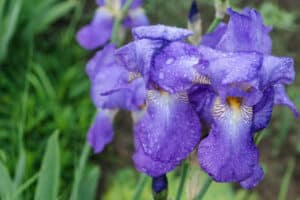
To grow Bearded Irises, it’s best to plant them in a location that receives full sun to partial shade. They prefer well-draining soil and should be planted with the top of the rhizome (the bulb-like structure that the plant grows from) just above the soil line. It’s important to make sure that the rhizome is not buried too deeply, as this can cause rotting.
When planting Bearded Irises, make sure to space them about 12-18 inches apart to give them room to grow. Water them regularly, especially during hot, dry weather, and fertilize with a balanced fertilizer every 6-8 weeks during the growing season.
One important tip for growing Bearded Irises is to divide them every few years. This helps to keep the plants healthy and encourages more blooms. Divide the plants in late summer or early fall, after they have finished blooming. With proper care and maintenance, Bearded Irises can provide years of beauty and fragrance to any garden.
6. Bee Balm
Bee balm, also known as Monarda, is a hardy and colorful perennial plant that is native to North America. It is named for its ability to attract bees and other pollinators to the garden. The flowers come in a range of colors, including red, pink, purple, and white, and have a sweet, spicy fragrance.

To grow Bee balm, it’s best to plant them in a location that receives full sun to partial shade. They prefer well-draining soil that is rich in organic matter. Sow the seeds indoors in early spring or plant them directly in the garden once the soil has warmed up.
When planting Bee balm, make sure to space them about 12-18 inches apart to give them room to grow. Water them regularly, especially during hot, dry weather, and fertilize with a balanced fertilizer every 6-8 weeks during the growing season.
One important tip for growing Bee balm is to keep an eye out for powdery mildew. This is a fungal disease that can affect the leaves of the plant and cause them to turn yellow or brown. To prevent powdery mildew, make sure to plant Bee balm in a location with good air circulation and avoid overhead watering.
With proper care, Bee balm can produce an abundance of colorful blooms that will attract bees, butterflies, and hummingbirds to your garden. It’s a great addition to any pollinator-friendly garden and will provide years of beauty and fragrance.
7. Begonia
Begonias are popular flowering plants that come in a wide variety of sizes, shapes, and colors. They are native to tropical and subtropical regions and are prized for their beautiful blooms and attractive foliage. Begonias can be grown as houseplants or outdoors in the garden.
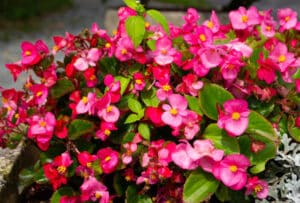
To grow Begonias, it’s best to plant them in a location that receives filtered or dappled sunlight. They prefer well-draining soil that is rich in organic matter. Sow the seeds indoors in late winter or early spring, or purchase established plants from a nursery or garden center.
When planting Begonias, make sure to space them about 6-12 inches apart, depending on the size of the plant. Water them regularly, making sure not to overwater, as this can cause root rot. Begonias prefer slightly moist soil, but they can tolerate some drying out between waterings.
One important tip for growing Begonias is to protect them from extreme temperatures. They are sensitive to both hot and cold temperatures and should be kept in a location where the temperature stays between 60-75 degrees Fahrenheit. If you plan to grow Begonias outdoors, make sure to plant them after the last frost and bring them indoors or cover them during cold weather.
With proper care, Begonias can produce an abundance of beautiful blooms and foliage that will add color and charm to any indoor or outdoor space.
8. Bellflower
Bellflowers, also known as Campanula, are charming and versatile perennials that are native to Europe and Asia. They are named for their bell-shaped flowers that come in a range of colors, including blue, purple, pink, and white. Bellflowers are easy to grow and can thrive in a variety of growing conditions.
To grow Bellflowers, it’s best to plant them in a location that receives full sun to partial shade. They prefer well-draining soil that is rich in organic matter. Sow the seeds indoors in late winter or early spring, or purchase established plants from a nursery or garden center.
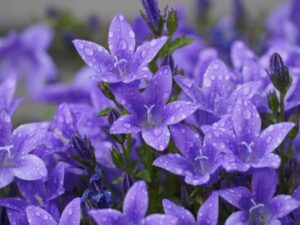
When planting Bellflowers, make sure to space them about 12-18 inches apart to give them room to grow. Water them regularly, especially during hot, dry weather, and fertilize with a balanced fertilizer every 6-8 weeks during the growing season.
One important tip for growing Bellflowers is to deadhead the flowers regularly. This means removing the spent blooms to encourage the plant to produce more flowers. It’s also a good idea to cut the plant back to the ground in the fall to prepare it for winter.
Bellflowers are versatile plants that can be grown in a variety of settings, including rock gardens, borders, and containers. With proper care, they can provide years of beauty and charm to any garden or outdoor space.
9. Bergamot
Bergamot, also known as Bee Balm or Monarda, is a colorful and fragrant perennial that is native to North America. It is named for its ability to attract bees and other pollinators to the garden. The flowers come in a range of colors, including red, pink, purple, and white, and have a sweet, spicy fragrance.
To grow Bergamot, it’s best to plant them in a location that receives full sun to partial shade. They prefer well-draining soil that is rich in organic matter. Sow the seeds indoors in early spring or plant them directly in the garden once the soil has warmed up.
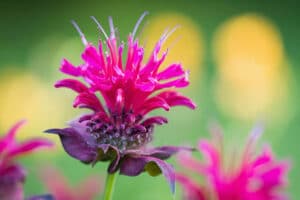
When planting Bergamot, make sure to space them about 12-18 inches apart to give them room to grow. Water them regularly, especially during hot, dry weather, and fertilize with a balanced fertilizer every 6-8 weeks during the growing season.
One important tip for growing Bergamot is to keep an eye out for powdery mildew. This is a fungal disease that can affect the leaves of the plant and cause them to turn yellow or brown. To prevent powdery mildew, make sure to plant Bergamot in a location with good air circulation and avoid overhead watering.
Bergamot is a great addition to any pollinator-friendly garden and will provide years of beauty and fragrance. With proper care, it can produce an abundance of colorful blooms that will attract bees, butterflies, and hummingbirds to your garden.
10. Bird Of Paradise
Bird of Paradise, also known as Strelitzia, is a stunning tropical plant that is native to South Africa. It is named for its unique and colorful blooms that resemble the feathers of a tropical bird. Bird of Paradise plants are commonly grown as indoor or outdoor ornamental plants, and can be enjoyed for their striking foliage as well as their blooms.
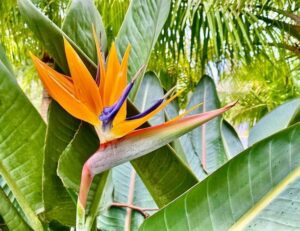
To grow Bird of Paradise, it’s best to plant them in a location that receives full sun to partial shade. They prefer well-draining soil that is rich in organic matter. Sow the seeds indoors in early spring or plant them directly in the garden once the soil has warmed up.
When planting Bird of Paradise, make sure to space them about 6-8 feet apart to give them room to grow. Water them regularly, making sure not to overwater as this can cause root rot. Bird of Paradise prefers slightly moist soil, but they can tolerate some drying out between waterings.
One important tip for growing Bird of Paradise is to protect them from extreme temperatures. They are sensitive to both hot and cold temperatures and should be kept in a location where the temperature stays between 50-70 degrees Fahrenheit. If you plan to grow Bird of Paradise outdoors, make sure to plant them in a sheltered location that is protected from strong winds.
With proper care, Bird of Paradise can produce an abundance of beautiful and exotic blooms that will add color and charm to any indoor or outdoor space.
11. Black-Eyed Susan
The Black-eyed Susan, also known as Rudbeckia, is a cheerful and hardy perennial that is native to North America. It is named for its distinctive dark brown center and bright yellow petals. Black-eyed Susans are easy to grow and can add a pop of color to any garden or outdoor space.
To grow Black-eyed Susans, it’s best to plant them in a location that receives full sun to partial shade. They prefer well-draining soil that is rich in organic matter. Sow the seeds in the spring, about 1/4 inch deep, and keep the soil moist until the seedlings emerge.
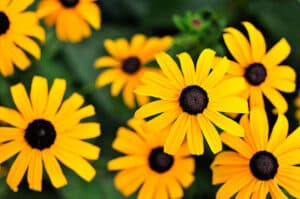
When planting Black-eyed Susans, make sure to space them about 12-18 inches apart to give them room to grow. Water them regularly, especially during hot, dry weather, and fertilize with a balanced fertilizer every 6-8 weeks during the growing season.
One important tip for growing Black-eyed Susans is to deadhead the flowers regularly. This means removing the spent blooms to encourage the plant to produce more flowers. It’s also a good idea to cut the plant back to the ground in the fall to prepare it for winter.
Black-eyed Susans are versatile plants that can be grown in a variety of settings, including borders, meadows, and containers. With proper care, they can provide years of beauty and charm to any garden or outdoor space.
12. Blanket Flower
The Blanket Flower, also known as Gaillardia, is a bright and cheerful perennial that is native to North and South America. It is named for its colorful, daisy-like blooms that come in a range of colors, including red, orange, and yellow. Blanket Flowers are easy to grow and can add a burst of color to any garden or outdoor space.
To grow Blanket Flowers, it’s best to plant them in a location that receives full sun to partial shade. They prefer well-draining soil that is not too rich in organic matter. Sow the seeds in the spring, about 1/4 inch deep, and keep the soil moist until the seedlings emerge.
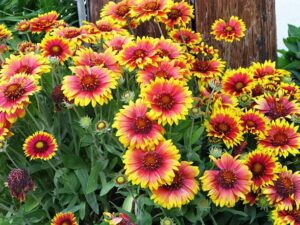
When planting Blanket Flowers, make sure to space them about 12-18 inches apart to give them room to grow. Water them regularly, especially during hot, dry weather, and fertilize with a balanced fertilizer every 6-8 weeks during the growing season.
One important tip for growing Blanket Flowers is to deadhead the flowers regularly. This means removing the spent blooms to encourage the plant to produce more flowers. It’s also a good idea to cut the plant back to the ground in the fall to prepare it for winter.
Blanket Flowers are versatile plants that can be grown in a variety of settings, including borders, rock gardens, and meadows. They are also drought tolerant, making them a great choice for hot and dry climates. With proper care, Blanket Flowers can provide years of beauty and color to any garden or outdoor space.
13. Bleeding Heart
The Bleeding Heart, also known as Dicentra spectabilis, is a beloved and charming perennial that is native to Asia. It is named for its unique heart-shaped pink or white flowers that appear to be dripping with blood. Bleeding Hearts are easy to grow and can add a touch of romance to any garden or outdoor space.
To grow Bleeding Hearts, it’s best to plant them in a location that receives partial shade to full shade. They prefer well-draining soil that is rich in organic matter. Sow the seeds indoors in late winter or early spring or purchase established plants from a nursery or garden center.
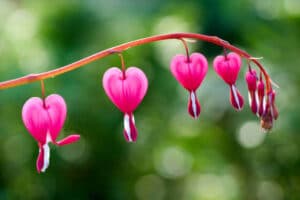
When planting Bleeding Hearts, make sure to space them about 12-18 inches apart to give them room to grow. Water them regularly, especially during hot, dry weather, and fertilize with a balanced fertilizer every 6-8 weeks during the growing season.
One important tip for growing Bleeding Hearts is to protect them from strong winds. The delicate flowers can be easily damaged by wind and rain. It’s also a good idea to cut the plant back to the ground in the fall to prepare it for winter.
Bleeding Hearts are popular in cottage gardens and shade gardens. They pair well with other shade-loving plants like hostas and ferns. With proper care, Bleeding Hearts can provide years of beauty and romance to any garden or outdoor space.
14. Blue Flag Iris
The Blue Flag Iris, also known as Iris versicolor, is a stunning perennial that is native to North America. It is named for its distinctive blue-purple flowers and sword-like leaves. Blue Flag Iris are easy to grow and can add a touch of elegance to any garden or outdoor space.
To grow Blue Flag Iris, it’s best to plant them in a location that receives full sun to partial shade. They prefer moist soil that is rich in organic matter. Sow the seeds in the fall, about 1/4 inch deep, or plant established plants from a nursery or garden center.
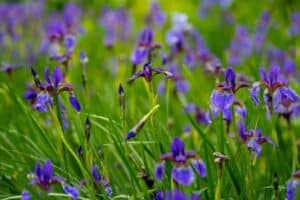
When planting Blue Flag Iris, make sure to space them about 12-18 inches apart to give them room to grow. Water them regularly, especially during hot, dry weather, and fertilize with a balanced fertilizer every 6-8 weeks during the growing season.
One important tip for growing Blue Flag Iris is to protect them from overcrowding. This plant can multiply quickly, and overcrowding can lead to disease and insect problems. It’s also a good idea to cut the plant back to the ground in the fall to prepare it for winter.
Blue Flag Iris is a popular choice for wetland areas and rain gardens. They are also great for adding color to pond and water garden areas. With proper care, Blue Flag Iris can provide years of beauty and elegance to any garden or outdoor space.
15. Blue Poppy
The Blue Poppy, also known as Meconopsis, is a stunning but challenging perennial that is native to the Himalayas. It is named for its distinctive blue blooms that are a rarity in the plant kingdom. Blue Poppies are prized by gardeners for their unique beauty and are often grown as a collector’s item.
To grow Blue Poppies, it’s best to plant them in a location that receives partial shade and is protected from hot, direct sunlight. They prefer moist, well-draining soil that is rich in organic matter. Sow the seeds indoors in early spring or purchase established plants from a nursery or garden center.
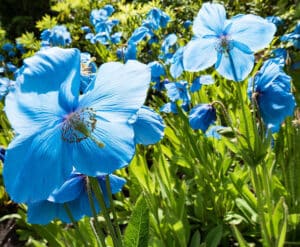
When planting Blue Poppies, make sure to space them about 12-18 inches apart to give them room to grow. Water them regularly, making sure not to overwater as this can cause root rot. Blue Poppies prefer slightly moist soil, but they can tolerate some drying out between waterings.
One important tip for growing Blue Poppies is to protect them from extreme temperatures. They are sensitive to both hot and cold temperatures and should be kept in a location where the temperature stays between 50-60 degrees Fahrenheit. If you plan to grow Blue Poppies outdoors, make sure to plant them in a location that is protected from strong winds.
Blue Poppies require specific growing conditions and can be difficult to grow successfully. But for those willing to put in the effort, they can produce an abundance of stunning blue blooms that are sure to impress. With proper care, Blue Poppies can provide years of unique and breathtaking beauty to any garden or outdoor space.
16. Bluebell
The Bluebell, also known as Hyacinthoides non-scripta, is a charming and delicate spring-flowering bulb that is native to Europe. It is named for its beautiful blue bell-shaped flowers that bloom in dense clusters. Bluebells are easy to grow and can add a touch of natural beauty to any garden or outdoor space.
To grow Bluebells, it’s best to plant them in a location that receives partial shade to full shade. They prefer moist, well-draining soil that is rich in organic matter. Sow the bulbs in the fall, about 2-3 inches deep and 3-4 inches apart.
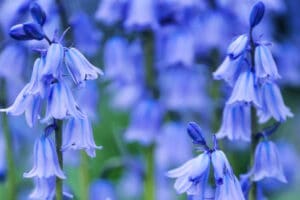
When planting Bluebells, make sure to water them well after planting and keep the soil moist until they begin to grow. Once they are established, they do not require regular watering, as they prefer slightly drier soil.
One important tip for growing Bluebells is to avoid digging up the bulbs after they have bloomed. Bluebells naturalize easily, meaning they spread and multiply on their own. If you disturb the bulbs, you may disrupt their natural growth cycle.
Bluebells are a great addition to woodland gardens, shady borders, and naturalized areas. They can also be planted in containers for a pop of color on the patio or balcony. With proper care, Bluebells can provide years of natural beauty and charm to any garden or outdoor space.
17. Bluebonnet
The Bluebonnet, also known as Lupinus texensis, is a beloved and iconic wildflower that is native to Texas. It is named for its beautiful blue-purple blooms that resemble a bonnet. Bluebonnets are easy to grow and can add a burst of color to any garden or outdoor space.
To grow Bluebonnets, it’s best to plant them in a location that receives full sun. They prefer well-draining soil that is not too rich in organic matter. Sow the seeds in the fall or early spring, about 1/4 inch deep, and keep the soil moist until the seedlings emerge.
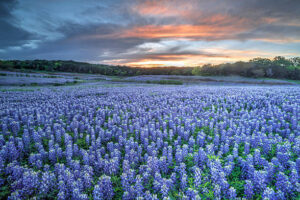
When planting Bluebonnets, make sure to space them about 6-8 inches apart to give them room to grow. Water them regularly, especially during hot, dry weather, and fertilize with a balanced fertilizer every 6-8 weeks during the growing season.
One important tip for growing Bluebonnets is to be patient. They can take up to two years to reach maturity and produce blooms. It’s also a good idea to avoid over-fertilizing, as this can lead to excessive foliage growth at the expense of blooms.
Bluebonnets are a popular choice for wildflower gardens, meadows, and roadside plantings. They are also the state flower of Texas and hold a special place in the hearts of many Texans. With proper care, Bluebonnets can provide years of beauty and color to any garden or outdoor space.
18. Bougainvillea
The Bougainvillea is a beautiful and vibrant flowering plant that is native to South America. It is named after the French explorer Louis Antoine de Bougainville, who discovered the plant in Brazil. Bougainvilleas are known for their bright and colorful bracts, which surround the small white flowers.
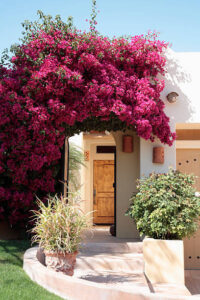
To grow Bougainvilleas, it’s best to plant them in a location that receives full sun. They prefer well-draining soil that is not too rich in organic matter. Bougainvilleas can be propagated from stem cuttings or purchased as established plants from a nursery or garden center.
When planting Bougainvilleas, make sure to space them about 6-8 feet apart to give them room to grow. Water them regularly, making sure not to overwater as this can cause root rot. Bougainvilleas prefer slightly dry soil and can tolerate drought once established.
One important tip for growing Bougainvilleas is to provide support for the vine-like stems. They can become heavy and require support, such as a trellis, fence, or wall. Prune them regularly to maintain their shape and encourage more blooms.
Bougainvilleas are popular for their showy blooms and ability to thrive in warm, tropical climates. They are often grown in containers and can be trained to climb up walls or trellises. With proper care, Bougainvilleas can provide years of stunning color and beauty to any garden or outdoor space.
19. Bourbon Rose
The Bourbon Rose is a beautiful and fragrant rose that is named after the French island of Bourbon (now called Réunion). It is a hybrid of two Chinese rose species and was first introduced in the early 19th century. Bourbon Roses are known for their repeat blooming and intense fragrance.
To grow Bourbon Roses, it’s best to plant them in a location that receives full sun to partial shade. They prefer well-draining soil that is rich in organic matter. Plant them in the spring or fall and water them regularly until they are established.
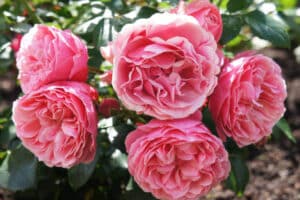
When planting Bourbon Roses, make sure to space them about 3-4 feet apart to give them room to grow. Water them regularly, making sure not to overwater as this can cause root rot. Bourbon Roses prefer moist soil, but they can tolerate some drying out between waterings.
One important tip for growing Bourbon Roses is to prune them regularly to maintain their shape and encourage more blooms. Prune in the early spring, removing any dead or diseased wood and shaping the plant as desired. Fertilize with a balanced fertilizer every 6-8 weeks during the growing season.
Bourbon Roses are a popular choice for rose gardens and can be grown in containers as well. They are also great for cutting and bringing indoors to enjoy their fragrance. With proper care, Bourbon Roses can provide years of beauty and fragrance to any garden or outdoor space.
20. Broomrape
The Broomrape, also known as Orobanche, is a parasitic plant that grows on the roots of other plants, such as clover, alfalfa, and tomato. Broomrapes are native to Europe, Asia, and Africa, and are often considered weeds. However, they do produce attractive flowers that can add interest to a garden.
To grow Broomrapes, it’s best to plant them in a location where their host plants grow. They require no soil or fertilizer, as they obtain their nutrients from the roots of their host plants. Broomrapes can be propagated from seeds or from the roots of established plants.
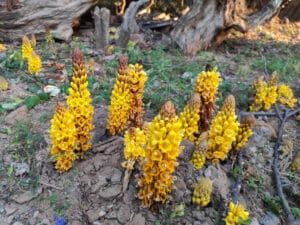
When planting Broomrapes, make sure to plant them near their host plants and water them sparingly. They prefer dry conditions and can tolerate drought once established. Broomrapes do not require pruning or fertilizing, as they rely solely on their host plants for nutrients.
One important tip for growing Broomrapes is to be aware of their parasitic nature. They can harm or kill their host plants, so it’s important to monitor their growth and remove them if they become too invasive.
Broomrapes are not commonly grown for their ornamental value, but they can add interest to a garden or naturalized area. With proper care, Broomrapes can provide years of unique and unusual beauty to any garden or outdoor space.
21. Brown-Eyed Susan
The Brown-eyed Susan, also known as Rudbeckia triloba, is a cheerful and easy-to-grow wildflower that is native to North America. It is named for its brown center disk and yellow petals that resemble the Black-eyed Susan. In fact, the two plants are very similar in appearance and care requirements.
To grow Brown-eyed Susans, it’s best to plant them in a location that receives full sun. They prefer well-draining soil that is not too rich in organic matter. Sow the seeds in the fall or early spring, about 1/4 inch deep, and keep the soil moist until the seedlings emerge.
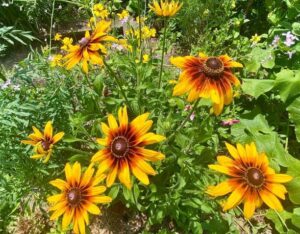
When planting Brown-eyed Susans, make sure to space them about 12-18 inches apart to give them room to grow. Water them regularly, especially during hot, dry weather, and fertilize with a balanced fertilizer every 6-8 weeks during the growing season.
One important tip for growing Brown-eyed Susans is to deadhead the flowers regularly. This means removing the spent blooms to encourage the plant to produce more flowers. It’s also a good idea to cut the plant back to the ground in the fall to prepare it for winter.
Brown-eyed Susans are versatile plants that can be grown in a variety of settings, including borders, rock gardens, and meadows. They are also drought tolerant, making them a great choice for hot and dry climates. With proper care, Brown-eyed Susans can provide years of beauty and color to any garden or outdoor space, much like their close relative, the Black-eyed Susan.
22. Brunfelsia
The Brunfelsia, also known as Yesterday-Today-and-Tomorrow, is a beautiful and fragrant flowering shrub that is native to South America. It is named for its unique blooms that change color over time, starting as deep purple or blue and fading to lavender and then white. Brunfelsia is a popular choice for gardens and outdoor spaces, especially in tropical and subtropical regions.
To grow Brunfelsia, it’s best to plant them in a location that receives partial shade to full sun. They prefer well-draining soil that is rich in organic matter. Plant them in the spring or fall and water them regularly until they are established.
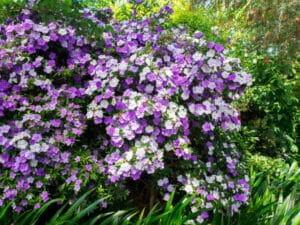
When planting Brunfelsia, make sure to space them about 6-8 feet apart to give them room to grow. Water them regularly, making sure not to overwater as this can cause root rot. Brunfelsia prefer moist soil, but they can tolerate some drying out between waterings.
One important tip for growing Brunfelsia is to prune them regularly to maintain their shape and encourage more blooms. Prune in the early spring, removing any dead or diseased wood and shaping the plant as desired. Fertilize with a balanced fertilizer every 6-8 weeks during the growing season.
Brunfelsia are a popular choice for gardens and outdoor spaces in tropical and subtropical regions. They can be grown in containers as well, making them a great choice for patios and balconies. With proper care, Brunfelsia can provide years of beauty and fragrance to any garden or outdoor space.
23. Bugleweed
The Bugleweed, also known as Ajuga, is a hardy and low-growing perennial that is native to Europe, Asia, and Africa. It is named for its small, trumpet-shaped flowers that bloom in shades of blue, pink, and white. Bugleweed is a popular choice for groundcovers and borders.
To grow Bugleweed, it’s best to plant them in a location that receives partial shade to full sun. They prefer well-draining soil that is moist but not waterlogged. Plant them in the spring or fall and water them regularly until they are established.
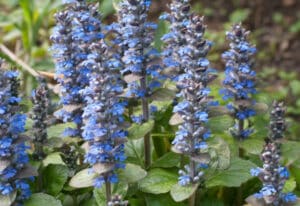
When planting Bugleweed, make sure to space them about 6-12 inches apart to give them room to grow. Water them regularly, especially during hot, dry weather, and fertilize with a balanced fertilizer every 6-8 weeks during the growing season.
One important tip for growing Bugleweed is to prune them regularly to prevent them from becoming too invasive. They can spread quickly and take over other plants, so it’s important to keep them in check. Prune them in the early spring, removing any dead or diseased foliage and shaping the plant as desired.
Bugleweed is a great choice for groundcovers, borders, and rock gardens. They are also great for planting in between pavers or in small spaces. With proper care, Bugleweed can provide years of low-maintenance beauty to any garden or outdoor space.
24. Butterfly Weed
The Butterfly weed, also known as Asclepias tuberosa, is a colorful and attractive perennial that is native to North America. It is named for its ability to attract butterflies with its bright orange or yellow flowers. Butterfly weed is a popular choice for butterfly gardens and naturalized areas.
To grow Butterfly weed, it’s best to plant them in a location that receives full sun. They prefer well-draining soil that is not too rich in organic matter. Sow the seeds in the fall or early spring, about 1/4 inch deep, and keep the soil moist until the seedlings emerge.
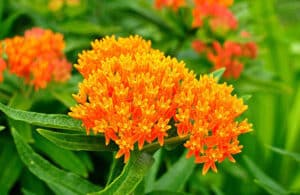
When planting Butterfly weed, make sure to space them about 12-18 inches apart to give them room to grow. Water them regularly, especially during hot, dry weather, and fertilize with a balanced fertilizer every 6-8 weeks during the growing season.
One important tip for growing Butterfly weed is to avoid overwatering. They prefer slightly dry soil and can tolerate drought once established. Deadhead the flowers regularly to encourage the plant to produce more blooms and prevent self-seeding.
Butterfly weed is a great choice for butterfly gardens and naturalized areas. They are also great for planting in containers or as part of a mixed border. With proper care, Butterfly weed can provide years of beauty and attract a variety of butterflies to any garden or outdoor space.
25. Buttercup
The Buttercup, also known as Ranunculus, is a bright and cheerful flowering plant that is native to Europe, Asia, and North America. It is named for its cup-shaped flowers that come in a range of colors, including yellow, white, pink, and red. Buttercups are easy to grow and can add a burst of color to any garden or outdoor space.
To grow Buttercups, it’s best to plant them in a location that receives full sun to partial shade. They prefer well-draining soil that is not too rich in organic matter. Plant them in the fall or early spring and water them regularly until they are established.
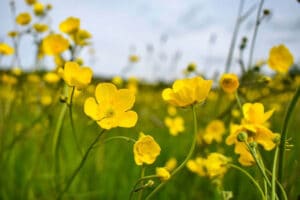
When planting Buttercups, make sure to space them about 6-8 inches apart to give them room to grow. Water them regularly, making sure not to overwater as this can cause root rot. Buttercups prefer slightly moist soil and can tolerate some drying out between waterings.
One important tip for growing Buttercups is to deadhead the flowers regularly. This means removing the spent blooms to encourage the plant to produce more flowers. Fertilize with a balanced fertilizer every 6-8 weeks during the growing season.
Buttercups are a popular choice for borders, rock gardens, and container plantings. They are also great for cut flower arrangements. With proper care, Buttercups can provide years of beauty and color to any garden or outdoor space.
26. Buttonbush
The Buttonbush, also known as Cephalanthus occidentalis, is a native North American shrub that is known for its unique round flowers and ability to attract pollinators, such as butterflies and bees. It is named for its clusters of small, ball-like flowers that bloom in shades of white or pink. Buttonbush is a great choice for wetland areas, rain gardens, or naturalized landscapes.
To grow Buttonbush, it’s best to plant them in a location that receives full sun to partial shade. They prefer moist to wet soil that is rich in organic matter. Plant them in the spring or fall and water them regularly until they are established.

When planting Buttonbush, make sure to space them about 6-8 feet apart to give them room to grow. Water them regularly, especially during hot, dry weather, and fertilize with a balanced fertilizer every 6-8 weeks during the growing season.
One important tip for growing Buttonbush is to prune them regularly to maintain their shape and encourage more blooms. Prune in the early spring, removing any dead or diseased wood and shaping the plant as desired. Buttonbush can also be propagated from stem cuttings or from root suckers.
Buttonbush is a great choice for wetland areas, rain gardens, or naturalized landscapes. They are also great for attracting pollinators and adding interest to a garden or outdoor space. With proper care, Buttonbush can provide years of beauty and environmental benefits.
27. Buttonwood
The Buttonwood, also known as Conocarpus erectus, is a native North American tree that is known for its salt tolerance and ability to withstand harsh coastal conditions. It is named for its small, button-like fruit that grows on the tree. Buttonwood is a popular choice for landscaping in coastal regions.
To grow Buttonwood, it’s best to plant them in a location that receives full sun. They prefer well-draining soil that is not too rich in organic matter. Plant them in the spring or fall and water them regularly until they are established.
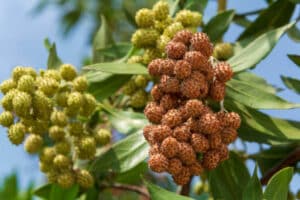
When planting Buttonwood, make sure to space them about 10-15 feet apart to give them room to grow. Water them regularly, especially during hot, dry weather, and fertilize with a balanced fertilizer every 6-8 weeks during the growing season.
One important tip for growing Buttonwood is to prune them regularly to maintain their shape and prevent them from becoming too large. Prune in the early spring, removing any dead or diseased wood and shaping the tree as desired.
Buttonwood is a great choice for landscaping in coastal regions, as they are tolerant of salt spray and can withstand harsh winds and conditions. They are also great for providing shade and adding interest to a garden or outdoor space. With proper care, Buttonwood can provide years of beauty and environmental benefits.
28. Byzantine Gladiolus
The Byzantine Gladiolus, also known as Gladiolus communis subsp. byzantinus, is a stunning and easy-to-grow flowering bulb that is native to the Mediterranean region. It is named for its vibrant magenta-purple flowers that bloom on tall spikes in late spring to early summer. Byzantine Gladiolus is a great choice for borders, rock gardens, and cut flower arrangements.
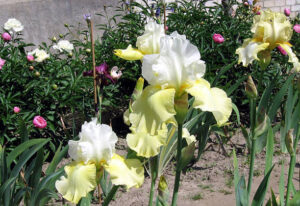
To grow Byzantine Gladiolus, it’s best to plant them in a location that receives full sun to partial shade. They prefer well-draining soil that is not too rich in organic matter. Plant the bulbs in the fall, about 3-4 inches deep and 6-8 inches apart.
When planting Byzantine Gladiolus, make sure to water them regularly until they are established. Fertilize with a balanced fertilizer every 6-8 weeks during the growing season.
One important tip for growing Byzantine Gladiolus is to stake the tall spikes to prevent them from bending or breaking in the wind. Deadhead the spent blooms to encourage the plant to produce more flowers.
Byzantine Gladiolus is a great choice for borders, rock gardens, and cut flower arrangements. They are also deer resistant and drought tolerant, making them a great choice for hot and dry climates. With proper care, Byzantine Gladiolus can provide years of beauty and color to any garden or outdoor space.
29. Blue Columbine
The Blue Columbine, also known as Aquilegia caerulea, is a beautiful and unique perennial that is native to the Rocky Mountains of North America. It is named for its distinctive flowers that resemble small, blue and white bonnets. Blue Columbine is a great choice for rock gardens, borders, and naturalized areas.
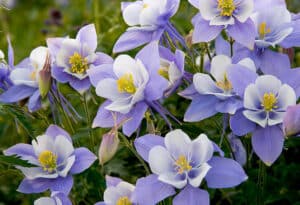
To grow Blue Columbine, it’s best to plant them in a location that receives partial shade to full sun. They prefer well-draining soil that is not too rich in organic matter. Plant them in the fall or early spring and water them regularly until they are established.
When planting Blue Columbine, make sure to space them about 12-18 inches apart to give them room to grow. Water them regularly, especially during hot, dry weather, and fertilize with a balanced fertilizer every 6-8 weeks during the growing season.
One important tip for growing Blue Columbine is to deadhead the flowers regularly. This means removing the spent blooms to encourage the plant to produce more flowers. Fertilize with a balanced fertilizer every 6-8 weeks during the growing season.
Blue Columbine is a great choice for rock gardens, borders, and naturalized areas. They are also great for attracting hummingbirds and adding interest to a garden or outdoor space. With proper care, Blue Columbine can provide years of beauty and color to any garden or outdoor space.
30. Blue Lotus
The Blue Lotus, also known as Nymphaea caerulea, is an aquatic plant that is native to Egypt and other parts of Africa. It is named for its unique and beautiful blue flowers that float on the surface of the water. Blue Lotus is a popular choice for water gardens and ponds.
To grow Blue Lotus, it’s best to plant them in a location that receives full sun to partial shade. They prefer water that is not too deep, about 6-18 inches, and a soil that is rich in organic matter. Plant the rhizomes in the spring or early summer and keep the water level consistent.
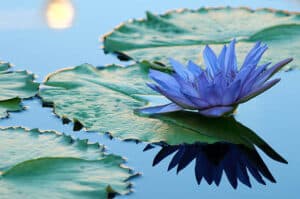
When planting Blue Lotus, make sure to use a container or planting basket to prevent the rhizomes from spreading too much. Water them regularly and fertilize with a water-soluble fertilizer every 6-8 weeks during the growing season.
One important tip for growing Blue Lotus is to deadhead the spent blooms regularly to encourage the plant to produce more flowers. Prune any dead or dying leaves or flowers to prevent them from rotting in the water.
Blue Lotus is a great choice for water gardens and ponds. They are also great for adding interest and beauty to any water feature. With proper care, Blue Lotus can provide years of beauty and tranquility to any garden or outdoor space.
And There Are Your Flowers Starting With B
In conclusion, we hope that this list of 30 awesome flowers starting with B has inspired you to add some new and exciting plants to your garden or outdoor space. From the stunning blooms of the Blue Poppy to the hardy and reliable Black-eyed Susan, there are plenty of options to choose from.
Remember, when planting any of these flowers, it’s important to choose the right location and provide them with the proper care and attention they need to thrive. Whether you’re planting in a sunny border or a wetland area, there is a flower on this list that is sure to fit your needs.
So, get out there and start planting! With a little effort and some patience, you can create a beautiful and vibrant garden full of these awesome flowers starting with B. Happy gardening!

Hi there, I’m Mark Apletree, a gardening enthusiast with a passion for gardening, and gardening tools. I’ll be your go-to guide for all things related to gardening. The purpose of this website is to assist you in selecting the most suitable garden gear that meets your specific requirements.
See All Posts

